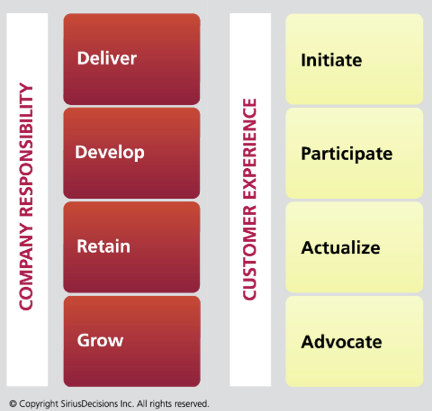It’s Not All About Buying: In Defense of Customer Marketing
In all this talk about the funnel (or waterfall) being dead, I’ve noticed an unsettling misunderstanding: How is it acceptable to tack on a single stage to the buying cycle, call it “the customer lifecycle,” and expect behavior to change? If the anti-funnel camp believes the buying view is too linear to reflect that process, then an over-simplified view of what happens after buying ends makes it worse. Any attempt to collapse an even more complicated relationship into a one-size-fits-all box doesn’t reflect the customer’s reality, or the seller’s for that matter.
Let’s try another approach to looking at the customer lifecycle. Let’s consider that a customer relationship is just that – a relationship. There are two parties involved: customer and company. At each stage of the lifecycle, both parties have needs, opportunity and responsibility if the relationship is to stay healthy. Most of our customers spend a lot more time with a company as customers than they do attached to a buying cycle. They progress through stages of their time as customers at varying rates, and don’t necessarily reach all of them. Sometimes there are buying cycles interspersed in that customer lifecycle. Just as there are typically multiple buyer roles engaged at different points in the buyer’s journey, there are also multiple customer roles who engage at different stages of the customer lifecycle. We may also invest differently in the customer’s experience, depending on the financial or strategic value and potential of the relationship over time.
Given all these factors, a single box attached to the buyer’s journey really isn’t sufficient to cover what’s inherently a complex and ever-evolving experience. It’s also very true that the demand waterfall, the buyer’s journey, and the customer lifecycle are related but not the same. The customer lifecycle requires its own measures, which sometimes overlap with what the demand waterfall captures, but more often must be tracked outside of it. Their goals are not the same.
Below is another view of the customer lifecycle as SiriusDecisions represents it. This framework is independent of the buyer’s journey, though a buyer’s journey is present before it begins and may be part of it again from time to time. It is true that an individual’s perception of the company and brand begin long before this view of the customer lifecycle begins, but we’re not looking to reflect the time before purchase, active buying and post-purchase all in one view. Instead, the goal is to provide guidance for what to do next, which covers a long time. It’s a way to anchor marketing and other functions that contribute to the customer’s experience in the understanding that the customer lifecycle is more than waiting for the next buying cycle. It deserves not just a box representing post-purchase purgatory but the full benefits of our best attention and execution.
